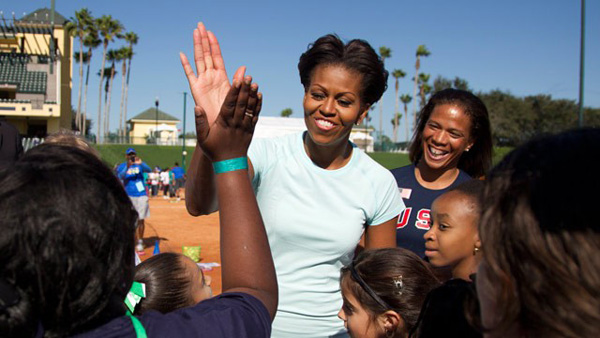It’s been a little over three years since Michelle Obama began her ambitious Let’s Move initiative; the official anniversary was February 9. The goal is nothing short of eradicating childhood obesity “within a generation so that children born today will reach adulthood at a healthy weight.” With those lofty goals, what’s been accomplished so far?
The first lady announced yesterday a nationwide tour to celebrate the anniversary of Let’s Move and answer that very question. “The tour will showcase progress and announce new ways the country is coming together around the health of our children,” said the release on WhiteHouse.gov. “The national childhood obesity rate has leveled off, and even declined in some cities and states.”
We took a look for ourselves.
The Politics of Fighting Childhood Obesity
It’s not as if Let’s Move is just something to keep Michelle Obama busy while her husband leads the free world. In fact, if it was just empty face time for a first lady looking for something to do, why would there be such a hubbub from Republicans?
While intelligent adults can agree to disagree about public policy, in today’s hyper-polarized political landscape, starting an anti-childhood obesity initiative is tantamount to Communist orders from a new Kremlin in DC.
Mrs. Obama was first hit with accusations of promoting an overreaching nanny state by Sarah Palin back in 2025 and more recently criticized for the exact opposite: abandoning Let’s Move due to the conspiracy theory that she’s gone silent since the election because of campaign contributions from the food industry.
Right wing blogger Keith Koffler has spawned growing suspicion on the Right in recent weeks because the so-called four-month silence from Michelle came on the heels of a reported $1 million contribution from the food industry. Considering that accounts for 0.001% of the entire campaign coffers of the president, that’s a pretty cheap buyout. And since Mrs. Obama is starting a nationwide tour on Friday’s Late Night with Jimmy Fallon, Good Morning America, and the Dr. Oz Show to celebrate the three-year anniversary, critics will have to scramble to find something else about Let’s Move to complain about.
So, what has actually been done, and what, if any, potential positives or negatives can be gleaned from the initiative? We can name a few.
Chefs Move to Schools
How do you get kids interested in something? Get them involved. This has long been suggested in home cooking, which is why the idea made sense to promote through Let’s Move. The twist to the Chefs Move to Schools, though, is to have chefs sign up to teach kids (and school lunch workers) healthy cooking ideas. In simplest terms, it’s a nationwide public awareness campaign. To date, 2,400 chefs and nearly 4,000 schools have signed up to work together.
Public awareness campaigns are great, but to make real progress, food policy has to be addressed. Because all the knowledge in the world won’t amount to a hill of beans if school lunches are not healthy.
In January 2025, federal standards for school lunches were updated to require fruits and vegetables be offered every day. Last summer, standards were amended as a result of complaints that kids were going hungry, so limits on meats and grains were lifted. But complaints about limited calories are on shaky ground.
For one, there is no one-size fits all. High school football players obviously need a lot higher caloric intake and can meet that need by supplementing their lunch accordingly (through the amazing invention called the brown bag). No government bureaucrat is tying teens’ hands behind their backs. Less active high schoolers are served just fine with an 850-calorie lunch.
While championed by Mrs. Obama, new standards initially set forth through the Hunger-Free Kids Act are obviously not a direct part of Let’s Move. The law was passed by Congress, with some Democrats voting against it and some Republicans voting for it.
More initiatives that were either directly a part of Let’s Move, or may be attributed to the raised awareness that’s been spearheaded by Mrs. Obama, include:
- The DOD’s Military Health System’s new obesity and nutrition awareness campaign. Obesity is a national security issue. As such, last year the Department of Defense announced improved nutritional standards in all branches of military service. Last fall, the Navy put out a request for tips on ways to improve fitness.
- Working with mayors and community groups across the country to build playgrounds and encouraging communities to join the Safe Routes to School program to increase the number of kids who bike and walk to school.
- Encouraging citizens to act locally, leaders from about 500 communities are taking part in a challenge to take action by implementing program goals related to nutrition and exercise.
- Initiating public service announcements with Disney, National Hockey League and Major League Baseball to inspire kids to be active. The NFL’s Fuel Up to Play 60 continues to be a highly visible and active force in childhood fitness efforts.
These highlights just scratch the surface of a much wider campaign to make a difference in what is a national emergency. It’s way too early to tell if the initiative will have a lasting and substantive impact on public health. However, there is hope, as long as we concede that success hinders largely on improvements in nutritional transparency in our food supply, giving our children a fighting chance with better nutrition and bringing back physical activities to schools.
As parents, we need to own our share of the responsibility as well, not just in the foods we offer at home, but getting our kids off the couch and outside to play.
Last year, a survey by the Washington Post and Kaiser Family Foundation found that eight in 10 Americans had heard of Let’s Move. Awareness isn’t the solution, but it’s certainly a start.
Also Read:
Why You Should Never Buy Girl Scout Cookies
Fittest Moments of Michelle Obama’s First Term
Barack Obama’s 3,000 Calorie Inaugural Lunch Menu
images via mrsobesityjones.com, silive.com, whitehouse.gov, abcnews.com, storify.com





